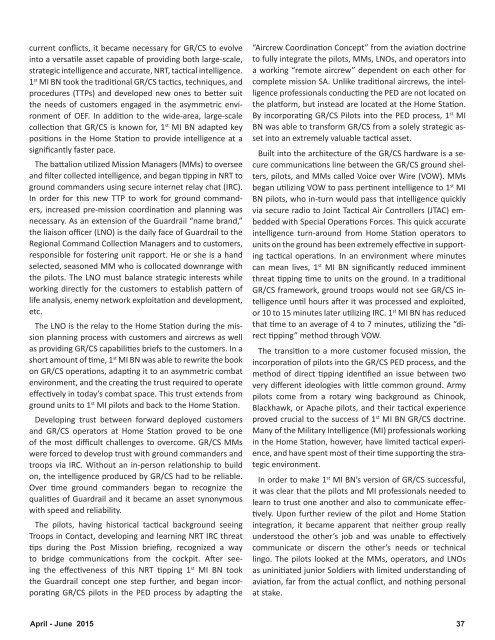incorrect
2015_02
2015_02
- No tags were found...
Create successful ePaper yourself
Turn your PDF publications into a flip-book with our unique Google optimized e-Paper software.
current conflicts, it became necessary for GR/CS to evolve<br />
into a versatile asset capable of providing both large-scale,<br />
strategic intelligence and accurate, NRT, tactical intelligence.<br />
1 st MI BN took the traditional GR/CS tactics, techniques, and<br />
procedures (TTPs) and developed new ones to better suit<br />
the needs of customers engaged in the asymmetric environment<br />
of OEF. In addition to the wide-area, large-scale<br />
collection that GR/CS is known for, 1 st MI BN adapted key<br />
positions in the Home Station to provide intelligence at a<br />
significantly faster pace.<br />
The battalion utilized Mission Managers (MMs) to oversee<br />
and filter collected intelligence, and began tipping in NRT to<br />
ground commanders using secure internet relay chat (IRC).<br />
In order for this new TTP to work for ground commanders,<br />
increased pre-mission coordination and planning was<br />
necessary. As an extension of the Guardrail “name brand,”<br />
the liaison officer (LNO) is the daily face of Guardrail to the<br />
Regional Command Collection Managers and to customers,<br />
responsible for fostering unit rapport. He or she is a hand<br />
selected, seasoned MM who is collocated downrange with<br />
the pilots. The LNO must balance strategic interests while<br />
working directly for the customers to establish pattern of<br />
life analysis, enemy network exploitation and development,<br />
etc.<br />
The LNO is the relay to the Home Station during the mission<br />
planning process with customers and aircrews as well<br />
as providing GR/CS capabilities briefs to the customers. In a<br />
short amount of time, 1 st MI BN was able to rewrite the book<br />
on GR/CS operations, adapting it to an asymmetric combat<br />
environment, and the creating the trust required to operate<br />
effectively in today’s combat space. This trust extends from<br />
ground units to 1 st MI pilots and back to the Home Station.<br />
Developing trust between forward deployed customers<br />
and GR/CS operators at Home Station proved to be one<br />
of the most difficult challenges to overcome. GR/CS MMs<br />
were forced to develop trust with ground commanders and<br />
troops via IRC. Without an in-person relationship to build<br />
on, the intelligence produced by GR/CS had to be reliable.<br />
Over time ground commanders began to recognize the<br />
qualities of Guardrail and it became an asset synonymous<br />
with speed and reliability.<br />
The pilots, having historical tactical background seeing<br />
Troops in Contact, developing and learning NRT IRC threat<br />
tips during the Post Mission briefing, recognized a way<br />
to bridge communications from the cockpit. After seeing<br />
the effectiveness of this NRT tipping 1 st MI BN took<br />
the Guardrail concept one step further, and began incorporating<br />
GR/CS pilots in the PED process by adapting the<br />
“Aircrew Coordination Concept” from the aviation doctrine<br />
to fully integrate the pilots, MMs, LNOs, and operators into<br />
a working “remote aircrew” dependent on each other for<br />
complete mission SA. Unlike traditional aircrews, the intelligence<br />
professionals conducting the PED are not located on<br />
the platform, but instead are located at the Home Station.<br />
By incorporating GR/CS Pilots into the PED process, 1 st MI<br />
BN was able to transform GR/CS from a solely strategic asset<br />
into an extremely valuable tactical asset.<br />
Built into the architecture of the GR/CS hardware is a secure<br />
communications line between the GR/CS ground shelters,<br />
pilots, and MMs called Voice over Wire (VOW). MMs<br />
began utilizing VOW to pass pertinent intelligence to 1 st MI<br />
BN pilots, who in-turn would pass that intelligence quickly<br />
via secure radio to Joint Tactical Air Controllers (JTAC) embedded<br />
with Special Operations Forces. This quick accurate<br />
intelligence turn-around from Home Station operators to<br />
units on the ground has been extremely effective in supporting<br />
tactical operations. In an environment where minutes<br />
can mean lives, 1 st MI BN significantly reduced imminent<br />
threat tipping time to units on the ground. In a traditional<br />
GR/CS framework, ground troops would not see GR/CS intelligence<br />
until hours after it was processed and exploited,<br />
or 10 to 15 minutes later utilizing IRC. 1 st MI BN has reduced<br />
that time to an average of 4 to 7 minutes, utilizing the “direct<br />
tipping” method through VOW.<br />
The transition to a more customer focused mission, the<br />
incorporation of pilots into the GR/CS PED process, and the<br />
method of direct tipping identified an issue between two<br />
very different ideologies with little common ground. Army<br />
pilots come from a rotary wing background as Chinook,<br />
Blackhawk, or Apache pilots, and their tactical experience<br />
proved crucial to the success of 1 st MI BN GR/CS doctrine.<br />
Many of the Military Intelligence (MI) professionals working<br />
in the Home Station, however, have limited tactical experience,<br />
and have spent most of their time supporting the strategic<br />
environment.<br />
In order to make 1 st MI BN’s version of GR/CS successful,<br />
it was clear that the pilots and MI professionals needed to<br />
learn to trust one another and also to communicate effectively.<br />
Upon further review of the pilot and Home Station<br />
integration, it became apparent that neither group really<br />
understood the other’s job and was unable to effectively<br />
communicate or discern the other’s needs or technical<br />
lingo. The pilots looked at the MMs, operators, and LNOs<br />
as uninitiated junior Soldiers with limited understanding of<br />
aviation, far from the actual conflict, and nothing personal<br />
at stake.<br />
April - June 2015<br />
37


